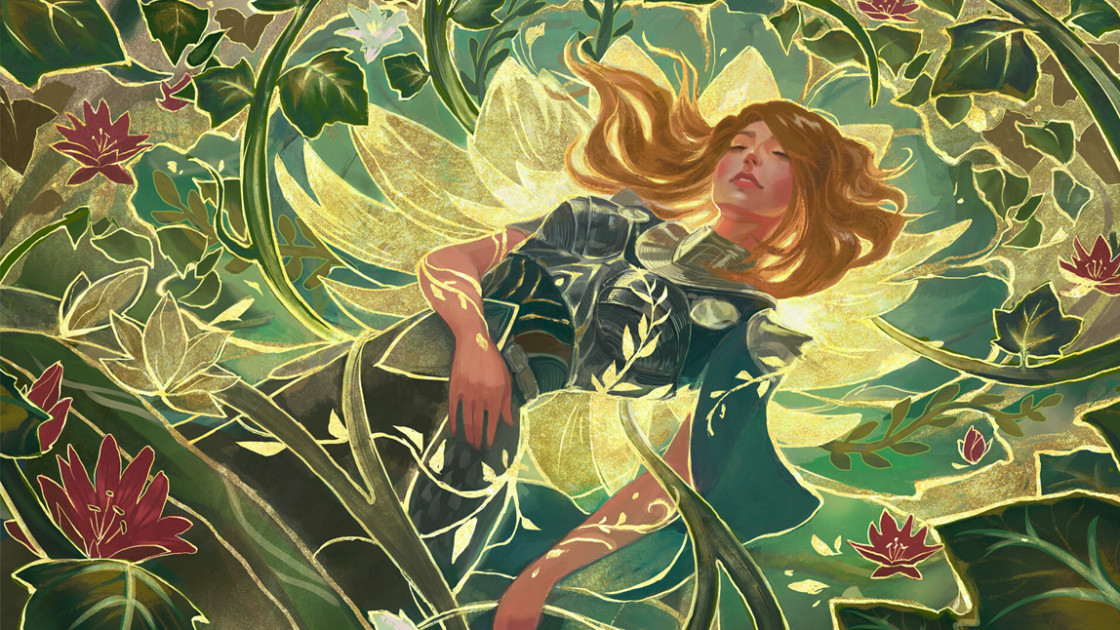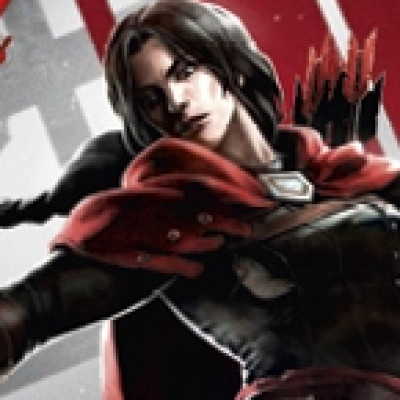From the moment a hero is spoiled, their deck is evolving. Flesh and Blood is a game of constant refinement. Players never truly stop tuning their decks for the ever-evolving metagame. Inevitably, the community at large lands on a few specific builds and versions. The almost-hivemind of online communities and competitive testing teams sync until they've narrowed down to a couple versions. Usually, these builds center on the same overarching strategy, just using different tools - such as Redline Cindra and Blue Cindra, or Flick Knives Ira versus the so-called “Boomer” variants that represent the classic playstyle. Occasionally, a hero has multiple distinct decks, such as Stealth Marionette and Dagger Marionette, or Death Dealer Azalea and Sandscour Azalea (Alex made me list that one).
On its own, this phenomenon isn’t anything noteworthy. It’s not uncommon in TCGs for established decks to have sub-variants. Archetypes aren't hard and fast lists so much as buckets, convenient groupings so players can conceptualize them. Within the variants, players are still making individual card choices to fit the meta and their playstyle.
Verdance, however, is a rarity in her flexibility. In 2025, Verdance has developed many viable options, such that a player can truly craft a deck to their liking. Put another way, most heroes don’t have a viable card pool so wide that the defining feature of the deck is personal taste instead of the staples. In her short time in the game, Verdance has already undergone sweeping changes not just to how she is perceived, but to her playstyle as well. Truthfully, she’s only become more varied as time has gone on. If you’re looking for a deck to truly express yourself and your preferences, there’s no better choice than the Thorn of the Rose.

From Seed to Sapling
The earliest versions of Verdance focused on setting up one particular combo kill: a stack of Healing Potions or Energy Potions with Surgent Aethertide and a Rampant Growth pitch stacked to make an arcane laser for 80+ damage. The rest of the deck quickly fell into place: life gain to supplement Rampant Growth turns, and defense reactions with disruptive Earth attacks to benefit from decompose. Enabling Verdance’s hero power wasn’t the goal; it was about enabling Felling of the Crown and Plow Under.



This build had a potent ceiling, but a disqualifying floor. Her absence from the competitive scene was all the more conspicuous in light of Rosetta's other heroes; Aurora and Florian surged to the spotlight, and for a little while even Oscilio seemed to be outperforming her. It took four further heroes reaching Living Legend to find the space she needed to grow. It wasn’t until this year's Road to Nationals season that we began to see just how flexible a hero she could be.
With the newly printed Shelter from the Storm and Ring of Roses in tow, Yuki Lee Bender took a unique - and some might even say audacious - approach to Verdance. Using the full rainbow suite of Rootbound Carapace, Yuki tried to clear her graveyard of all the powerful decompose attacks during her opponent’s turn, allowing her to abuse Nourishing Emptiness. To support keeping a five-card hand on line, she included a higher density of arcane attacks. Overflow the Aetherwell and Snapback opened up tempo options with Waning Moon in aggro and midrange matchups, taking the place of Command and Conquer and other large attacks previously thought to be auto-includes.

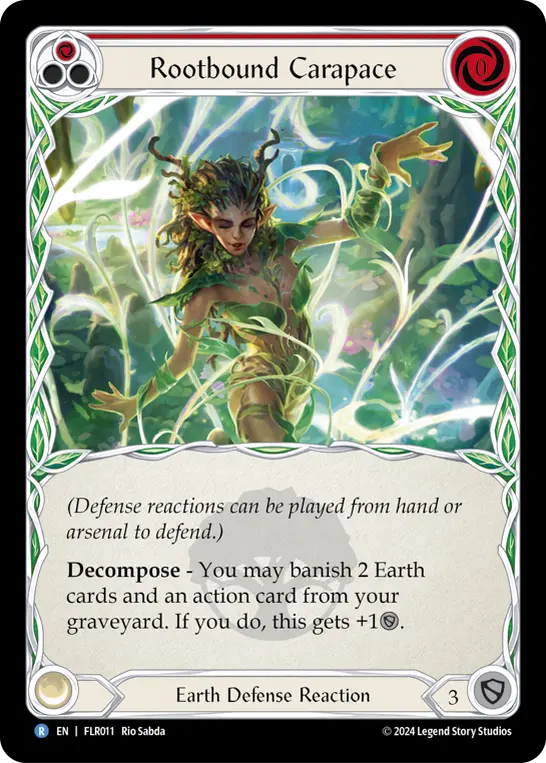

Yuki’s version was short-lived. It was clear from the outset that Yuki built it with her own preferences and playstyle in mind, and similar builds haven’t found success since. Many dismiss her variant as a flash in the pan. On reflection, however, it was an early representation of exactly what Verdance became.
Yuki marks the turning point in the community’s perception of Verdance. Once seen as a much-beloved niche combo-control deck or a grappler with an odd toolset, Yuki’s list captivated the wider player base. It was a new and unique twist on a favorite hero struggling to find her place. It revealed that Verdance could take on several forms, and it planted the seeds for the diverging playstyles that characterize her today.
Garden Theory
Verdance decks have multiple viable components - and in truth, these components are present to varying degrees in most lists. The evidence of her flexibility is in how these components can fill vastly different roles based on the pilot’s preferences.
The best way to think about Verdance is to think of her as a garden. Making a garden is not as simple as just planting seeds and watering them. It takes effort to till the space, to lay down the fertilizer and mulch - but there’s an extra step novice gardeners often take for granted: making sure your plants play nice with each other. While it’s rare for two species of plants to be actively harmful to one another (aside from one hogging up the resources you provide), lasting gardens, especially vegetable and fruit gardens, are built with synergy in mind. I’m not just talking about symbiotic relationships; I mean making your garden into a full ecosystem where all the moving parts benefit each other, creating one cohesive whole.
Some plants - especially edible ones - have specialized pests evolved to eat them. Other plants attract insects that eat those pests. Some have deeper roots that only take certain nutrients, but pull all nutrients up with them. This moves those nutrients closer to the surface, allowing more shallow-rooted but beautiful flowers to get additional food from the soil. Some deter deer and other problem animals. Some berry varieties will fruit early, and others late; savvy gardeners can accommodate both to have an additional harvest in the year.
The best part is, whether you’re growing for food, beauty, or both, different plants can fill the same role, which lets your garden look exactly how you want. If there’s a deer problem, you can grow rosemary, lavender, or lamb’s ear. You have a good choice of different ferns to help move nutrients. There are dozens of beautiful flowers that attract pollinators for berry bushes; there are also plenty of “plain” plants that do the same, if you want less of a visual spectacle.

Verdance follows a similar dynamic. Like a garden, there are several components that all fit the same role or classification, but accomplish it in different ways. Building a Verdance deck is an exercise in filling those functions, while allowing the pilot to cater the deck to their preferences. In general, these components can broadly be put into three archetypes:
- Physical attacks
- Arcane attacks
- Setup cards
While these could be further subdivided, we'll take a macro approach to better understand the roles they fill.
Physical Attacks
The Earth talent is no stranger to powerful physical attacks, and neither is the “battle mage” archetype. Bullander proved that a Wizard can throw haymakers and come out ahead on tempo, and that principle lives on today in Verdance. While the game has changed since the rise of Bullander, the core principle is still true today: physical attacks provide more tempo, and depending on the build, either put the opponent in range of more evasive arcane kills (including her combo), or supplement an arcane-focused gameplan.
Of course, with Verdance’s printing came some of the most powerful Earth cards the game has ever seen. Iyslander played physical attacks because she needed a better way to present damage. Verdance plays them because they synergize with three cards that are too good not to play.



(We’ll cover Rootbound Carapace later; for now, let’s focus on the first two.)
Plow Under and Felling of the Crown are possibly two of the most powerful cards ever printed. In addition to their devastating abilities, they get power boosts from having four Earth cards in your banished zone. Because they fuel their own static abilities, on a certain level each successive copy could be more powerful than the last.
This brings us to the major difference between Bullander and Verdance: the quality of physical attacks within the Earth card pool is vastly superior to what’s available to Iyslander. It’s not that Fyendal’s Fighting Spirit and Wounded Bull are bad cards, per se; they’re just outclassed. While Iyslander’s physical attacks were primarily about damage, Verdance gets to enable her damage with other decompose cards - especially Rootbound Carapace and Cadaverous Tilling - while playing Command and Conquer to boot. These are the physical attacks most commonly seen, and almost every list that placed during ProQuest: Singapore season ran them at minimum.
Additionally, the roles these cards can play is much, much more flexible than in Iyslander, and it becomes more obvious if we compare lists. Let’s take a look a look at Majin Bae’s U.S. Nationals-winning list from this year:
In addition to the usual suspects, Majin Bae opted to include a few utility options. Enlightened Strike is likely a fixing card to convert hands that had to block awkwardly. Summer’s Fall is an excellent inventory option, and the red copies are explicitly to threaten damage in addition to its decompose. While every Verdance deck features some copies of Fruits of the Forest - and by and large I deem it a setup card - the decision to include the red copies in addition to blues indicates Majin wanted the option to throw a large breakpoint.


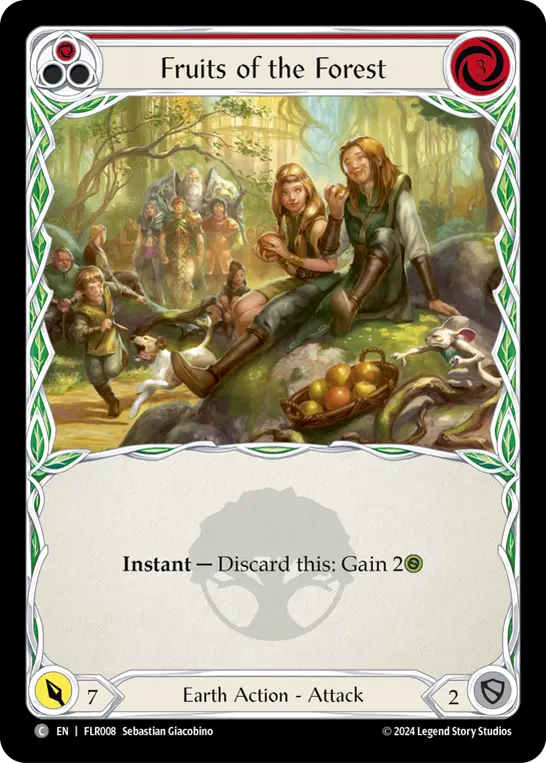
Majin Bae’s list is an example of a value-oriented approach to physical damage. Every attack - other than the blue Autumn’s Touch, which is ubiquitous as a 3-block that pitches - serves a utility role. The only attack that isn’t obviously either disruptive or a setup card is Cadaverous Tilling. In truth, the card is an early decompose eight power attack: a Felling of the Crown-scale attack available at any point in the game.
It’s hard to argue with his approach. He brought a solid suite of attacks to cover his bases, and it clearly paid off. Looking at the rest of his list, it has enough arcane damage to use Waning Moon for tempo. We’ll set that point aside for now, but suffice to say: for Majin Bae, physical attacks are the primary source of damage, and each has added utility to free up space in the rest of the deck for setup cards and solid arcane damage output.
Notably, what he doesn’t do is include attacks fom damage’s sake - save Cadaverous Tilling, which may be closer to Rootbound Carapace in its role as an extremely powerful decompose card at all stages of the game. Another way we might look at this is, he’s playing only the disruptive attacks to make space for other categories of cards.
Some take a different approach. Instead of only playing the disruptive attacks, they make throwing 6’s the primary focus. This is the core embodiment of Rathe Times editor Alex Truell’s take on Verdance, which carried him to Top 8 in this season’s ProQuest.
Alex’s list is in many ways a cousin to Majin's - but the distinctions between them result in a very different gameplan. Based on The Teklo Foundry's list, this list uses Evergreen and a spicy playset of Sound the Alarm, giving it the option for an endgame that is no longer centralized around Rampant Growth. Indeed, Alex points to this as one of the strengths of the list: no matter the opponent, this list always had a path to success available to it.



I think few choices encapsulate Alex's strategy as much as yellow Fruits of the Forest. Blue is a staple in every list, but his decision to run yellow over red is very telling. The yellow is still 6 power, but it can also pitch into Surgent Aethertide - leaving him with the option to play a 2-card hand with any of the 0-cost arcane spells in his deck. Of course, it can also be thrown as an attack with that same blue 0-cost. This choice reflects his commitment to keeping pressure on every turn, focusing on a tempo gameplan, and it truly is the most flexible card in his list.
Brayden (Ocean) Pritchard took a similar approach to a first place finish. His list looks by and large the same, but features Bullander all-star Fyendal’s Fighting Spirit, which hasn’t seen competitive play in some time.

What can be gleaned from these lists? Physical damage is the primary means for all of them. However, the purpose for them differs. Majin Bae kept the tightest list to maximize his 80 slots, ensuring every card had utility alongside damage. Alex Truell and Brayden focused on keeping the heat coming, taking a tempo approach by demanding the opponent give two cards to block or leak damage. The difference is in the strategy of the deckbuilding phase. Alex and Brayden adopt a more punchy posture that can trade blows, while Majin Bae aims more for resilience.
The Physical Core of Verdance
These cards tend to make up Verdance's physical suite.
- Felling of the Crown
- Plow Under
- Command and Conquer
- Cadaverous Tilling (R)
- Autumn’s Touch (B)
- Fruits of the Forest (B)
- Summer’s Fall (R or B, in the inventory)
A build considering going heavier in this role has many options available to it, ranging from raw damage to flexibility and even tech choices. While the options are nigh-limitless, these attacks should always be up for consideration.
- Evergreen (R or B)
- Fyendal’s Fighting Spirit (R)
- Enlightened Strike
Arcane Damage
Verdance decks have to balance their physical damage with their arcane output. This doesn’t mean it needs to be equal; rather, they need to find the right balance for how they aim to win. Too many setup cards without enough arcane to capitalize on it will leave you drawing the wrong half of your deck.
Across all the examples so far, there are two decision points to be made on arcane damage:
- The decision to include Waning Moon, Surgent Aethertide, or both.
- Which disruptive sources to include.



The arcane damage part of Verdance appears nearly solved, for those who want it to play the typical role. Destructive Aethertide and Scour for disruption, and Emeritus Scolding to increase the range of a potential Rampant Growth kill off the back of Storm Striders. With the release of High Seas, Burn Bare now fills the same role and doubles as a popper. Mind Warp is extremely powerful with Channel the Millennium Tree, and demands arcane barrier. Pulsing Aether // Life is simply too flexible not to include, being arcane damage that can be decomposed.



It seems that the real point of divergence comes down to the weapon. The default weapon for most of Verdance’s lifespan was Surgent Aethertide for the combo. However, as time has gone on, more and more players seem to favor Waning Moon in addition to Surgent, or even on its own entirely. Waning Moon opens the door to a tempo-oriented gameplan - an arcane version of Alex Truell’s stance on physical attacks. Both Brayden and Alex stuck to only Surgent for this ProQuest season - if we wanted to hazard a guess, they may see their physical attacks as fulfilling Moon’s role. Majin Bae, with his more limited suite, chose to include both.
He does, however, have one glaring omission from his list.

Channel the Millennium Tree has been a staple of Verdance since the hero’s inception. It’s a way to force damage, and notably a way to unlock powerful surge effects, especially against arcane barrier 2 or below. With additional amp effects, Tree becomes a monster of a card that is easy to keep on the board. For a time, it was even considered the most powerful card in the deck.
Majin Bae registered zero copies of the card for U.S. Nationals.
At first glance, this seems like an obvious miss. The card is clearly powerful, and even similar attack-heavy lists we examined play it. Upon closer inspection however, Majin Bae has no true use for the card. Unlike Alex and Brayden, Majin Bae played with zero surge effects. Alex and Brayden run Mind Warp and Destructive Aethertide. In order to make these cards worth playing, they need an enabler.
The other space we see Tree in is for combo turns. Majin Bae plays a total of five Potion effects. The amp is significantly less useful in the combo role because of how many resources Majin Bae can setup without being forced into combo turns based on Tree and draws. If Alex and Brayden need the extra reach, they have to factor keeping Tree in play when planning for the next cycle. It’s not enough to play Channel the Millennium Tree for damage alone; it has to synergize with something in the deck to keep it from being too inconsistent and below rate.
Of course, this isn’t the only way Verdance can be built. There’s an option I’ve been experimenting with for some time: one with a heavy arcane focus, with physical damage taking a back seat.


Mine is a variation of Blazing for Lethal’s list from several months ago. This started as a pet project because I was drawn to Verdance as a new player, but couldn’t afford Felling of the Crown. While Blazing played it, of course, this was a shell that I could adopt without them for now. It ended up being much cheaper, while still being fun to bring to an Armory. I didn’t hold any loftier ambitions for Verdance, so this was a perfect fit for me.
I won’t share my list here because it’s far from done - and unfortunately a list from Blazing isn't available right now. My take on Verdance is to pair Surgent Aetheride/Waning Moon with 1 for 4’s to send 6 arcane as often as possible, or trigger surge - depending on the matchup. With Channel the Millennium Tree and Surgent Aethertide, we can threaten 2 card 12s in arcane.

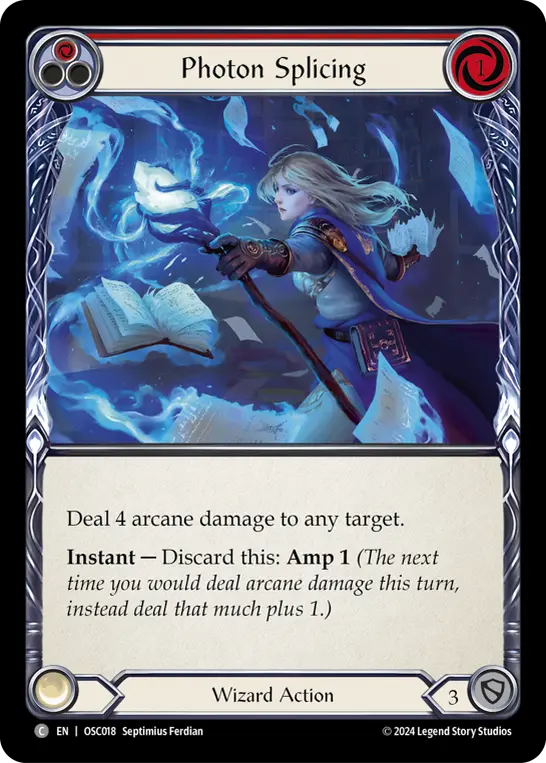
My take leans into exploiting arcane as evasion. Some cards I’ve tested, like Arcane Twining, double as amp fuel to try to force a pitch to respect surge, or gain the surge in the first place. I’ve tested different arcane spells, even Sonic Boom and Overflow the Aetherwell.
Inherently, my build focuses on the Potion combo side. To buff our other spells - and create a truly massive stack of damage - I play Aether Flare and combo it with Snapback. This lets us carry over the amp from Rampant Growth one more step off of Surgent, with Snapback as the final payload at instant speed. In a pinch, we could go off at instant speed with Storm Striders and Energy Potions, which have largely been my preference over Healing Potions.


Of course, to compensate for deck building space, I play less physical attacks. Outside the aforementioned staple blues, I only run playsets of Cadaverous Tilling, Command and Conquer, and Plow Under. Some days, when I don’t feel like swapping my Command and Conquers between decks, I play red Fruits of the Forest instead. I play a few copies of Summer’s Fall in the Inventory, but that’s all in terms of physical attacks.
Of all the lists discussed, mine is the only one that hasn’t placed highly in an event, and I wouldn’t take it to one to begin with. So why do I mention it? It further showcases Verdance’s flexibility - if we’re willing to account for players’ goals. If you’re looking for something to take to Armory, or even just a budget deck, arcane-focused Verdance is a powerful and fun option that does win games.
The Arcane Core of Verdance
When selecting the arcane cards, the following are essentially staples:
- Burn Bare
- Pulsing Aether // Life
- Emeritus Scolding (B)
The real choice lies in whether or not to lean into surge effects. If electing to play them, the best options at time of writing are:
- Channel the Millennium Tree
- Destructive Aethertide
- Mind Warp
- Pop the Bubble (B)
If you're not on surge, consider disruption and value.
- Aether Arc
- Scour
If considering a heavy arcane build, these are the cards that have performed for me in addition to the previous options.
- Aether Quickening (R)
- Photon Splicing (R)
- Aether Flare (R and B)
- Snapback (R and B)
- Overflow the Aetherwell (R)
Setup Cards
There’s not much variance in Verdance’s setup cards. While Rootbound Carapace (Y) occasionally makes an appearance, the decompose package is largely set in stone. This leaves the combo elements. Thanks to High Seas, Pounamu Amulet can now be joined to the Potion slot.



The community has been back and forth on which potions are best since the hero was first spoiled. Healing Potion allows for a much larger combo turn, but Energy Potion allows that combo to be played at instant speed, which is often necessary. Early in Verdance’s life, Healing Potion was the dominant potion, and as time went on, Energy Potion gradually took its spot. It appears that Healing Potion is the predominant potion again. A playset of Healing Potions is present in all the lists we’ve discussed. Furthermore, the only Energy Potion is in Majin Bae’s list, and he’s gone so far as to run Pounamu Amulet in addition to the Healing Potions. It seems that the attack-heavy decks have chosen height over speed.
The Setup Core of Verdance
Keeping this in mind, the go-to Potion setup appears to be either:
- A full playset of Healing Potion
or
- A full playset of Energy Potion
and
- 1-2 of the potion not selected
and
- Optionally, 1 Pounamu Amulet
There's also consideration to be given to supplementing decompose. Truthfully, the only cards that fit this role are:
- Rootbound Carapace (Y or B)
- Fruits of the Forest (R or Y)
In general, if your list leans heavier on physical attacks, additional copies of Fruits of the Forest see more play. If your list leans more defensive, it may want more copies of Rootbound Carapace.
Bearing Fruit
What can be gleaned from all of this? Each pilot built a list to their own preference, and their deckbuilding choices speak volumes.
Alex Truell and Brayden (Ocean) Pritchard opted for a physical-focused gameplan, one that gets ahead on tempo with large attacks. In both cases, their arcane damage is focused on disruption and reach for closing out a game. By focusing solely on Surgent Aethertide and Healing Potion, they have an almost ‘Arcane Guardian’ feel to them, where they aren’t unhappy to block 6, play a Potion, and arsenal their last card.
Majin Bae’s take is built to be the peak of flexibility. By culling his physical attack selection, he had the space in his inventory to adopt any posture needed in any given matchup. Combined with Verdance’s natural tendency to adjust her ratios for the second and third cycles by blocking and pitching, Majin Bae’s 80 cards are the result of a modular approach to deckbuilding.
The common thread in all of them is that each of these pilots chose the same hero and overall strategy for their respective events, and chose different ways to accomplish them. All of them placed highly, and two of them won their events.
As for my personal list, it further emphasizes the takeaway: like a garden, Verdance is varied in her composition. She is the epitome of personal expression in the deck building stage. Like a flower, Verdance’s variety may wither and die with time, settling into a set meta build at last - but if you’ve been looking into Verdance, there isn’t a better time than now, where you can take her in almost any direction – tempering for your goals – and find success.

